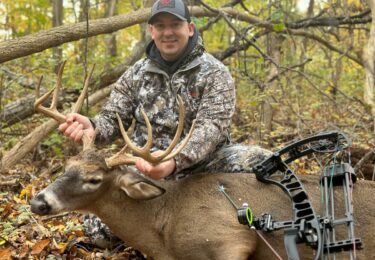We have all heard and/or used the term “point blank range” at some point in our lives, usually to make fun of someone who missed an easy shot. But what does this phrase actually mean and where did it come from?
Point Blank Range is defined as the range at which a bullet’s trajectory remains within a defined target area.
For example, let’s take a target that is 6 inches in diameter, which is conveniently the typical size of a deer’s vitals. The point-blank range for shooting a deer can be explained as the range of distance (for a particular rifle) in which you will hit the 6″ vitals without having to adjust your scope or perform a “Kentucky windage” calculation.
This can be further described by a graph. Let’s take a typical deer rifle into consideration. The graph below shows the typical trajectory in blue (bullet drop over distance) for a common 30 caliber bullet sighted at 100 yards. The orange dashed lines represent the 6″ vitals (3″ above the center and 3″ below the center). As you can see, this particular rifle has a point-blank range of about 175 yards. This means that as long as the deer is inside of that range (or as long as the blue line is within the orange dashed bounds), just aiming directly at the animal will provide a kill shot. Beyond 175 yards an adjustment of some kind will need to be made.
Now, how can we use this knowledge to our advantage for close-range shooting? *Remember we are using a 6-inch target in these examples, so if there is a desire to be more accurate for smaller animals (say 4 or 5 inches) you need to take that into consideration.
1. Your sight height can be changed to increase/decrease your rifle’s point-blank range. The sight height is simply the height (in inches) from the center of the barrel to the center of the scope. Increasing the sight height (by adding a Picatinny rail, etc.) will separate the
barrel from the scope more, making you more inaccurate at close ranges (but still within the 6″ circle) but will increase the point blank range of the rifle. For example, take a look at the graph below. The original trajectory (blue) is still shown which used the common sight height of 1.5 inches. The new red trajectory is the same exact bullet combination but with a sight height of 2.5 inches. You can see that the point-blank range of this particular rifle has been extended to about 200 yards.
2. Determining the best range to sight your rifle to is the next way we can use point blank range to our advantage. Most of us typically just sight our rifles at common yardages like 50, 100, or 200 yards, but putting some thought into this can be a huge advantage for the short-range shooter. Using simple online bullet drop calculators, we can
actually determine what the best sight in the range is to maximize the point blank range. Using our same bullet combination and back to our typical 1.5 inch sight height, the new yellow trajectory shows that to get the best point blank range out of the rifle, it should be sighted in just over 220 yards. The goal of this process is to capture the trajectory inside the entire spectrum (above and below 0) of the target size. Now, no range has targets placed at 220 yards, but it does not matter. By looking at the graph, we know that this rifle sighted in at 220 yards will be 2.5 inches high at 100 yards. So you can simply just sight your rifle at 2.5 inches high at 100 yards to fit this trajectory. Using this method you can see that the point blank range has now been extended to 250 yards! That is a 75-yard gain from what we started with.
By: Brian Halchak


